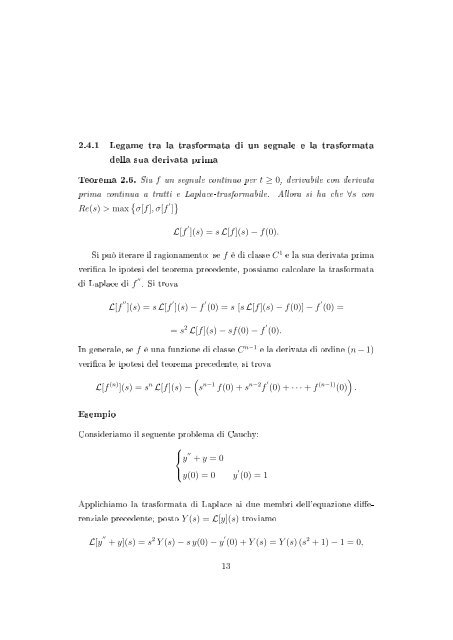1 La trasformata di Laplace
1 La trasformata di Laplace
1 La trasformata di Laplace
- No tags were found...
Create successful ePaper yourself
Turn your PDF publications into a flip-book with our unique Google optimized e-Paper software.
2.4.1 Legame tra la <strong>trasformata</strong> <strong>di</strong> un segnale e la <strong>trasformata</strong>della sua derivata primaTeorema 2.6. Sia f un segnale continuo per t ≥ 0, derivabile con derivataprima continua a tratti e <strong>La</strong>place-trasformabile. Allora si ha che ∀s conRe(s) > max { σ[f], σ[f ′ ] } L[f ′ ](s) = s L[f](s) − f(0).Si può iterare il ragionamento: se f è <strong>di</strong> classe C 1 e la sua derivata primaverica le ipotesi del teorema precedente, possiamo calcolare la <strong>trasformata</strong><strong>di</strong> <strong>La</strong>place <strong>di</strong> f ′′ . Si trovaL[f ′′ ](s) = s L[f ′ ](s) − f ′ (0) = s [s L[f](s) − f(0)] − f ′ (0) == s 2 L[f](s) − sf(0) − f ′ (0).In generale, se f è una funzione <strong>di</strong> classe C n−1 e la derivata <strong>di</strong> or<strong>di</strong>ne (n − 1)verica le ipotesi del teorema precedente, si trovaL[f (n) ](s) = s n L[f](s) −()s n−1 f(0) + s n−2 f ′ (0) + · · · + f (n−1) (0) .EsempioConsideriamo il seguente problema <strong>di</strong> Cauchy:⎧⎨y ′′ + y = 0⎩y(0) = 0 y ′ (0) = 1Applichiamo la <strong>trasformata</strong> <strong>di</strong> <strong>La</strong>place ai due membri dell'equazione <strong>di</strong>erenzialeprecedente; posto Y (s) = L[y](s) troviamoL[y ′′ + y](s) = s 2 Y (s) − s y(0) − y ′ (0) + Y (s) = Y (s) (s 2 + 1) − 1 = 0,13
















